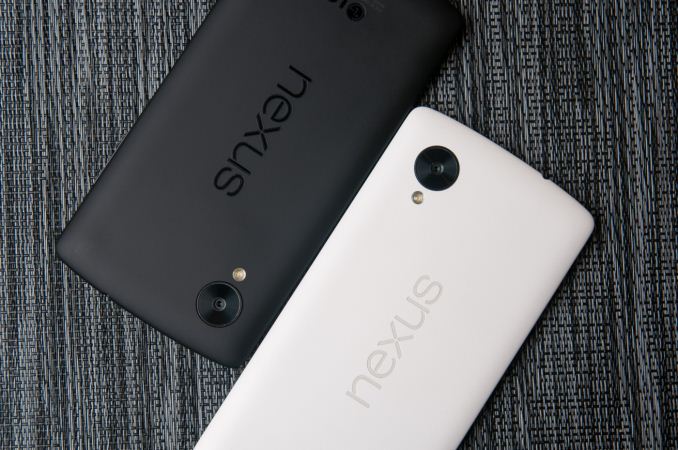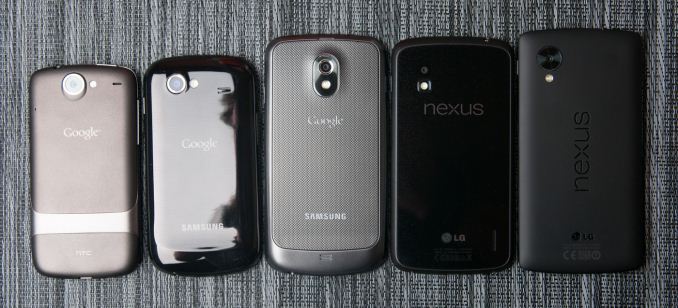Google Nexus 5 Review
by Brian Klug on December 5, 2013 8:00 AM EST- Posted in
- Smartphones
- LG
- Android
- Mobile
- Snapdragon 800
- Android 4.4
- Nexus 5
As is often the case, the conclusion to this Nexus review is one part software, and one part hardware. I'll start with a discussion of Android 4.4.
Google adds a subtle but appreciated level of polish to the Android UI with its latest iteration of the OS. This has been true for a while now, but the Android we're talking about today is really a far departure from what existed back in the early 2.x days. Anyone who hesitated to move from iOS back then will find themselves with an OS today that is clearly a substitute good. What once was an OS that only appealed to a crowd that appreciated its flexibility is now just as approachable as anything else on the market, and just as powerful as it always has been.
Likewise, Android is now smoother than before thanks to further improvements brought forth by project butter and refinements to the GPU-accelerated 2D rendering pipeline that was introduced in Android 3.x Honeycomb. Like any platform, it's still possible to craft apps that jank, but you have to look hard for examples that truly drag the experience down, and on the whole almost all the system apps are polished and performant. Project svelte also reduces memory footprint for midrange (emerging market) devices with 512 MB of RAM, where most of the remaining growth is for the smartphone market abroad and at home. I can't wait to see how that bears itself out even on devices like the Moto G with 1 GB of RAM or less, since it's hard to immediately find the difference on flagships with 2 GB or more that aren't always under high memory pressure.
I'm glad to see the antiquated SMS/Messaging app gone, but I'm puzzled by the poor integration into Google's new Hangouts app. The Hangouts experience in Android remains incredible, but the SMS component is far from the sort of seamless integration I had hoped for.
The most disappointing part about Android 4.4 is the miserable camera UI, but I'll get to its impact on the Nexus 5 in a moment.
For the price, the Nexus 5 is easily one of the best buys on the market today. At $349 you not only get the absolute latest hardware, but the most accurate 1080p display available on an Android device. I really can't give Google enough credit here for doing what literally no other Android OEM seems to care enough about and actually shipping a display with proper sRGB coverage. It's not quite as good as what you'll get from a 2013 Nexus 7, but it's easily the best I've ever encountered in all of my experience with Android devices.
It's good to see the default storage capacity move from 8GB to 16GB, but I would really like to see Google embrace even larger options. There's no reason Google couldn't offer a 64GB Nexus 5, and/or be a little aggressive on NAND sourcing and push for a 128GB model as well.
The fact that the Nexus 5 ships unlocked at its price point is another huge selling point. It seems to me that what you can get for $179, $349 and $599 is improving substantially across the market. I would love to see Google extend the Nexus family both up and down the pricing spectrum to really provide excellent solutions for all segments of the market.
The camera story on the Nexus 5 is among the most frustrating aspects of this phone. From a hardware perspective, Google has settled on a combination of sensor and optics that's quite close to the most optimal configuration available today, and a dramatic improvement from the Nexus 4. The problem with the Nexus 5's camera is entirely limited to the horrible mess that is the default Android camera app. We're nearly into 2014 yet substantial shutter lag, focusing issues and a preview that doesn't reflect reality are still problems with the AOSP camera. The fact that many other Android OEMs have already worked around some if not all of these issues is hugely disappointing. Depending on how important the camera experience is to you will really determine whether or not the Nexus 5 is a good fit. Google has apparently told other publications that software fixes are on the way, but it's currently impossible to gauge the magnitude of improvement coming down the pipe.
Thankfully, we find ourselves in a time where there are a number of excellent options in the Android space.
Quite possibly the closest alternative to the Nexus 5, while still retaining the mostly-stock Android experience, is Motorola's Moto X. You lose out on core count and display resolution, but in return you get a smaller/more comfortable body, potential for color customization, and a far more usable camera today. The Moto X is just a much more polished device overall, and something you can also find on Verizon (not an option for Nexus 5). If having access to virtually-stock Android is of value to you and you want a cleaner experience today, the Moto X is a great alternative to the Nexus 5.
On the other end of the spectrum there's LG's G2 - the Nexus 5's closest hardware relative. Here you also get a much more functional camera offering and even better battery life. The tradeoff is of course that you lose the stock Android UI and the display isn't as accurate (it is however slightly larger), but it's absolutely a liveable option if you value things like a usable camera.
Google is really so close to perfecting the Nexus as a smartphone. Nexus 5 is a huge improvement over Nexus 4, and the obvious upgrade for Nexus 4 users, it just still needs a few refinements before I can comfortably recommend it to normal smartphone shoppers. For enthusiasts seeking the device that will get Android updates first, or shoppers looking for optimal value, the Nexus 5 is a definite buy.












231 Comments
View All Comments
hamiltenor - Thursday, December 5, 2013 - link
Great review, I avoid The Verge like the plague lately. AnandTech, Ars Technica and to a lesser extent, Tom's Hardware are basically the only useful technology news sites from my point of view.Few typos, but I won't bother complaining. It's clear what you meant and they don't detract from the effort or lengths you went to for this review.
Looking forward to the line-out audio comparison!
cheinonen - Thursday, December 5, 2013 - link
I'm working on the article as fast as I can. I had to get another sample of a phone to verify something but I believe I have enough data to write it now. It's just big so it'll take a few days possibly. Lots of work to get done but it's coming ASAP.hrrmph - Thursday, December 5, 2013 - link
I will add to others comments that waiting for you guys to get it right is totally worth it. In spite of my nitpicks, Brian did great on this review, and I'm glad to hear that you are handling audio as a dedicated project.I am very interested to see what you find on your audio quality investigations, especially since 90% of my audio consumption is now via mobile devices with content as follows:
- 80% are WMA-LossLess rips from redbook CDs;
- 10% mp3-360kbs from Amazon; and
- 5% FLAC 24-bit from various sources (and growing on this one).
Having tried numerous devices, I will comment in advance that I find the BlackBerry Z10 to be great for commuting in a noisy environment (good oomph for cutting through rumble over the car speakers) and the Samsung Note 2 and Samsung S-ATIV seem well refined for quiet environment listening at my desks (home and work).
My point being that the sound "profiles" of these devices may not be perfectly accurate, but nonetheless both have their applications and usefulness.
96 and 192KHz / 24-Bit recordings are gradually making their way into my collection in increasing numbers and I'm really enjoying the sound. So HD-Audio is also an interest, especially for material that can make good use of the bandwidth.
WinPhone 8 generally cannot handle FLAC audio files, thus the Blackberry and Samsung Android are my go-to devices for music now. I use them with Sennheiser, Grado, or B&W cans over my head depending where I am at (home / work / travel).
I occasionally use a Gen 1 Asus Nexus 7 for audio listening - it is okay but clearly isn't as good as the Blackberry and Samsung devices, is on par with Zune, and much improved over the old Sansa devices. Hopefully they further improved the audio quality in the Gen 2 device, although I will skip it for other reasons.
The Z10 has excellent volume, while the Note 2 is too quiet in the car on some songs... thus indicating that some devices need supplementary amplification to reach satisfying volume on some songs. Hopefully sound volume issues will get addressed in future mobile devices.
Impulses - Friday, December 6, 2013 - link
Looking forward to this.Alpeshkh - Thursday, December 5, 2013 - link
Ah, should've curbed my excitement and read the display section fory that PSR thing!cgalyon - Thursday, December 5, 2013 - link
Could the camera performance be significantly improved with use of another camera app? I would be interested in seeing if you could do a comparison of the camera performance in the stock app, Camera Awesome, and VSCO Can. My thinking is that it could give us very valuable information on if the camera experience could in fact be one of the best on Android when provided with capable software. Thanks for the very detailed review!Tetracycloide - Thursday, December 5, 2013 - link
Most of the camera negatives are implemented before an app would be given camera data I think. Will require an OS update. 4.4.1 is supposed to be that OS update so we shouldn't have to wait long.AncientWisdom - Thursday, December 5, 2013 - link
Also VERY interested in this.... We know the problem, question is are third party camera apps the solution?blind2haters - Thursday, December 5, 2013 - link
Dude...the metal ring around the lens IS for magnetic lenses... It has already been tested and confirmed. Great research...not.Brian Klug - Thursday, December 5, 2013 - link
Nope. http://cl.ly/image/0o2a2d342R0oEntirely cosmetic at this point.
-Brian